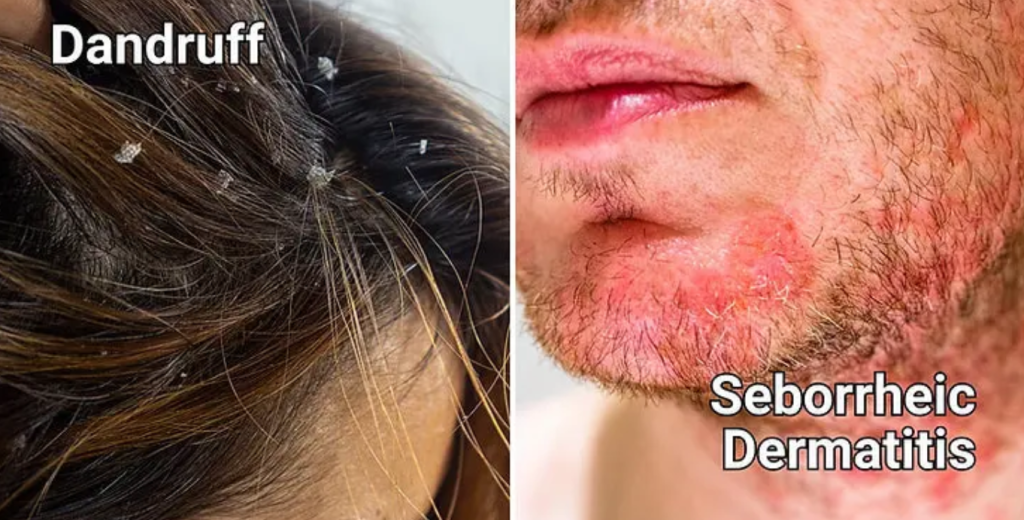
What is Seborrheic Dermatitis?
Seborrheic Dermatitis (SD) is a chronic, inflammatory skin condition that primarily affects areas rich in oil glands such as the scalp, face (especially around the nose and eyebrows), behind the ears, and sometimes the chest. It causes flaky, white to yellowish scales, redness, and sometimes mild itching or burning. It is one of the most common causes of persistent “dandruff” and dry, flaky facial skin.
It’s not contagious, and not due to poor hygiene. It can, however, recur in cycles and vary in severity depending on environmental factors, stress, and skincare habits.

Common Symptoms
- Persistent white or yellow flakes on the scalp (often mistaken for dandruff)
- Flaky skin on the sides of the nose, eyebrows, and sometimes forehead
- Itching or burning in affected areas
- Greasy or oily patches with white scales
- Redness or irritation (especially in colder seasons or stressful periods)
- Worsens during cold, dry weather, or after stressful events
Root Causes
The exact cause of Seborrheic Dermatitis isn’t fully understood, but major contributing factors include:
- Overgrowth of Malassezia yeast: A naturally occurring skin fungus that, when overactive, can irritate skin and lead to flaking.
- Excess oil production: Oil (sebum) from the skin acts as a breeding ground for Malassezia.
- Genetic predisposition: Some individuals are more prone to developing SD.
- Environmental factors: Cold weather, low humidity, and indoor heating can worsen symptoms.
- Stress and fatigue: Can weaken the skin’s barrier and immunity, triggering flare-ups.
- Certain illnesses: Conditions like Parkinson’s disease or immune deficiencies can increase susceptibility.
Areas Commonly Affected
- Scalp (most frequent)
- Sides of the nose
- Eyebrows and in-between
- Behind the ears
- Forehead
- Chest or upper back (in severe cases)
Diagnosis
Seborrheic Dermatitis is typically diagnosed clinically by a dermatologist based on appearance and history. In chronic or unclear cases, a skin biopsy or scraping may be done to rule out psoriasis, eczema, or fungal infections.
Treatment and Management
There’s no permanent cure, but symptoms can be effectively controlled and prevented with proper treatment and maintenance.
1. Face Treatment
Medication:
- Ketoconazole 2% Cream: Most effective antifungal cream.
- How to use:
- Apply a thin layer on the flaky areas (nose, eyebrows) once daily at night.
- Continue for 2–4 weeks, then reduce to 2–3x/week for maintenance.
- Moisturizer:
- Use a non-comedogenic moisturizer in the morning (look for ceramides, niacinamide, or hyaluronic acid).
- Avoid:
- Harsh exfoliators, scented soaps, or alcohol-based products.
2. Scalp Treatment
Medication:
- Ketoconazole 2% Shampoo (e.g., Nizoral)
- How to use:
- Use 2–3 times per week.
- Lather into scalp and leave for 5 minutes before rinsing.
- Alternate with a gentle, non-medicated shampoo.
- Other options: Zinc pyrithione shampoo, Selenium sulfide shampoo, or Coal tar-based shampoo.
Maintenance:
- Once controlled, reduce to once per week use of medicated shampoo.
- Continue moisturizing face daily to avoid flare-ups.
Daily Skincare & Haircare Routine
Morning:
- Gentle, fragrance-free cleanser
- Moisturizer (non-comedogenic)
- Sunscreen (optional but recommended)
Night:
- Cleanser
- Ketoconazole Cream (on affected areas)
- Light moisturizer (optional)
Haircare:
- Wash hair 2–3x/week using Ketoconazole shampoo
- Avoid scratching scalp or using harsh brushes
- Do not over-oil the scalp
Lifestyle and Preventive Tips
- Hydrate well — drink plenty of water
- Manage stress — practice meditation, yoga, or deep breathing
- Sleep adequately — skin repairs itself at night
- Avoid triggers — cold, dry weather, alcohol-based products
- Use a humidifier indoors during winter months
- Balanced diet — include B-complex vitamins (esp. B2, B6, and B12)
When to See a Dermatologist
- No improvement after 3–4 weeks of treatment
- Severe redness, pain, or swelling
- Flaking spreads to new areas
- Suspected secondary bacterial infection
Final Thoughts
Seborrheic Dermatitis can be persistent and frustrating, but with the right skincare routine, medications like Ketoconazole, and a little patience, it can be effectively controlled. Regular maintenance is key, and flare-ups can often be prevented with simple lifestyle adjustments.
By understanding the condition and using targeted treatments, you can greatly reduce symptoms and regain confidence in your skin and scalp health.